I talked yesterday about all the “questionable” Chinese “too good to be true” harp guitars from Tropical Moon (and/or others operating under constantly changing eBay monikers).
Amazingly, alongside those instruments are 2 actual “too good to be true” China-made instruments – one, a harp guitar, and one, a whole line of multi-string guitars.
The harp guitar – in case you’ve missed the insane buzz building since the last Harp Guitar Gathering – is the brand new Holloway Dyer copy. Unlike the Lark in the Morning – which, however they describe it, is miles away from a copy – the Holloway is a fairly accurate copy. Why/how? Scott Burwell (the man behind the vision) started by having the factory simply follow the plans. He also used his own vintage Dyer to fine-tune certain things (including 6 sub-basses). Quality and appearance have been very good on the successive prototypes (many of which I’ve had the privilege of pawing), and is also being methodically tweaked, with constant communication and multiple trips overseas for Scott. One thing present from the beginning (Prototype #1, still in Scott’s possession) is ridiculous tone. Some have sounded different from others, but all have that Dyer sound in some way. Stephen Bennett and the other endorsers would not be on the Holloway website if the instruments weren’t happening. They are, for the price, literally “too good to be true.”
No, I’m not affiliated with Holloway in any way, other than as an eventual dealer. But I know the two constant questions: How much? and When? The answers are still TBD. No matter what the price points are, they will be cheaper than the Larks, with a quality case included. And I won’t be rubbing it in on the commercial Harp Guitar Music site when I list them, but can give you my 2 cents here: They are an exponential order of magnitude better in every possible way.
I expect to have some available any week now (knock wood).
Yesterday, Javen wrote about 3 instrument options. The baritone guitar option is beyond my scope, but the other – 10-string guitar – is appropriate, though things are going to get a bit complicated.
You’ve seen the Bartolex instruments on eBay? Made in China? Well, they are the real deal. Bartolex was started by one Neris Gonzalez, who – much like Scott Burwell with the harp guitar – saw the need for low-priced, entry-level 10-string (and other multi-string) guitars. He, also, made the right connections in China and has been producing them for a while now, with a pretty impressive full line of instruments. He sold them on eBay from the beginning, and soon, 10-string player Stephen Bright was a U.S. dealer. Stephen, whose site is Cathedral Guitars, sells them on eBay as “10-string classical harp guitars.” I’ll tell you why in a minute. Stephen now has his own line of Bartolex 10-strings, and tells me this:
“The guitars are made in Guangzhou, China, in a western-trained factory that also makes OEM classical guitars for other well-known classical guitar brands. There are several dealers around the world. Neris is based in Madrid, and I am the USA dealer for multi-strings, and there are other dealers in a few other countries.
“My particular focus has been on getting the price point low enough to be affordable since the luthier-made 10-strings have always been prohibitively expensive for most players who might otherwise have an interest. With that in mind, we have made a brand new line of Cathedral Guitars, which are from the same factory, with the same high-quality materials and workmanship, but with reduced detailing to keep the price down. These guitars come in Romantic Tuning (D,C,B,A) and can, of course, be retuned/restrung as the user sees fit. They are amazing instruments on their own, but for the price/performance, they are unequaled. They compete with and often surpass luthier-made instruments selling in the $4,000 – $6,000 range.”
Stephen’s Cathedral Guitar line consists of three 10-string models ranging in price from $999-$1500. The Barolex line is much wider, with different string counts, fan frets, and many other options. I noted that on the Bartolex site, all the instruments are simply listed as “7-, 8-, 10-, or 11-string” – no “classical” (though they are all nylon-string Spanish-style guitars), and no “harp.”
So why am I giving so much blog space to 10-string guitars and Stephen Bright, my “sworn, harp guitar enemy”? (that’s tongue in cheek, for any irony-challenged readers).
Because Javen asked about the option in his original email and I wanted to acknowledge this excellent alternate option for musicians. So far, there are no low-budget nylon-string harp guitars (though there will be one day, I bet). A lot of people ask me, and I always recommend old Vienesse kontra-gitarres as one option, and trolling the luthier list for those who have built nylon-string HGs (there are many). The latter are not usually in the $1500 range of course (many kontras are, but you have to know what you’re getting). I do not recommend 10-strings or other multi-strings – simply because I can’t. They are not harp guitars. And harp guitars is my sole business.
It’s also the sole topic of Harpguitars.net. My site, of course, goes into many different harp guitar “cousins” and legitimate relatives, but labeled as such, for point of history, and point of comparison. You may have noticed that the Bartolex 10-string is shown in two different Harpguitars.net Galleries: Extended Range Guitars, and Fretted Harp Guitars. How? Why?
Very simple: Because this same 10-string instrument can be used in two specific ways. One is as a standard multi-string, where all ten strings are fretted by the left hand as needed musically. The other is as in a harp guitar, where the lowest basses are never fretted. That’s how Stephen plays it. He never (he swears to me!) frets the last couple strings, and so chooses to call himself a “classical harp guitarist” and his instrument a “10-string classical harp guitar.” This site’s readers know that his term is organologically incorrect, but my concern is that the term will only serve to confuse the public to their detriment. You can play it “like a harp guitar” all day long, but at the end of the day, it’s still not a harp guitar. It has to have floating strings. But Stephen (a long-time internet friend) and I have been all over it and decided to live and let live (at any rate, it is apparently a free country…).
However, there is a category to put Stephen’s (and others’) version of a fully-fretted instrument where only open notes are used on certain strings, and of course (like defining “harp guitar”), I had to create that category: Fretted Harp Guitars. Yes, the term seems an oxymoron, but it is nevertheless simple and legitimate. Because many builders and players have also created such an instrument. And for purposes of clarity, this “performance practice-driven” classification had to be acknowledged and defined (the definitions of each Gallery are at the top).
In the case of Bartolex instrument(s), they belong in the Extended Range category for the most part. For Stephen’s same 10-string, we place it alternately in the organological category Fretted HGs – the intent of the performer becomes the defining parameter over form or construction.
Fascinating, huh? Believe me, this musicology concept-crunching has taken me years and zillions of hours. It isn’t easy. But as always, someone has to do it!
One last caveat, and it’s important and serious: Stephen wanted to come to the Gathering to show and sell his 10-string guitars. I welcomed him to come for the weekend, but to keep the instrument in his room. We are The Harp Guitar Gathering, plain and simple. That’s the whole point. Yes, it’s a nit-picky organological point that keeps this instrument out (it literally would just need one floating string unfretted!), but as Stephen admitted, “I do understand your need to draw the line, though, and unfortunately these guitars land just on the other side of it.” He also thought they’d be of interest to the harp guitar world, and that’s true – that’s why I’ve discussed them (at length!) here, for people like Javen who can’t decide whether to try one or the other. The 10-string classical guitars are certainly great options for those wanting nylon strings. But for those wanting nylon strings and a harp guitar, you’ll have to look further. Floating strings rule!

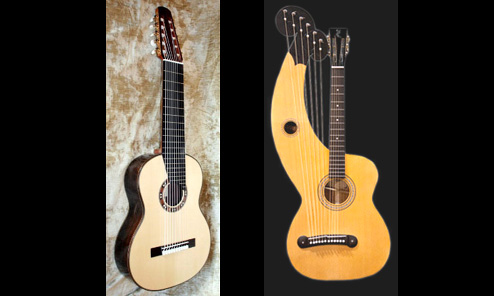

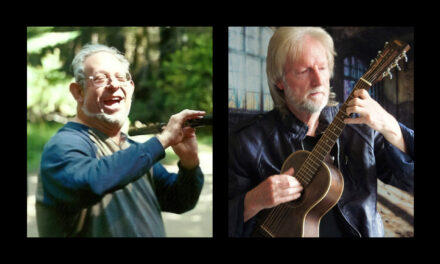
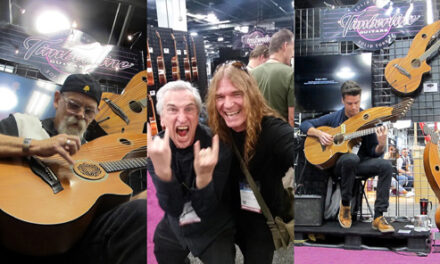
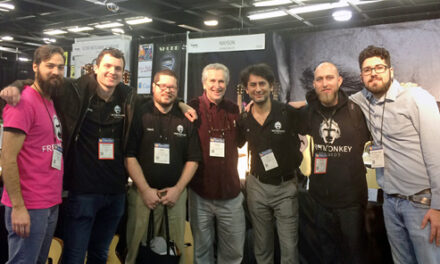
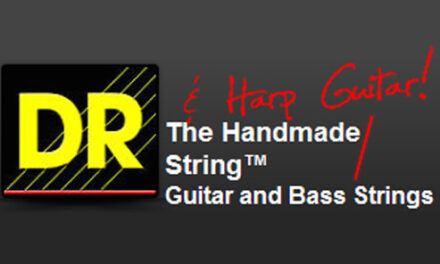
Well, the plot thickens, there’s also the “Schumacher Style” 11 string that is designed to be tuned like 1) renaissance lute in E, 2) baroque lute in F, 3) Archlute in E and a re-entrant tuned theorbo in A. The Schumacher Style guitar is standard string length (65 cm) and has a Hauser style body. This allows guitar players to play nearly all the existing lute and theorbo literature they desire while playing on an instrument that is the same string length as their “normal” guitar. BTW, tuning this instrument like a guitar is like having a frontally nude picture of Madame “X” and looking only at the elbows and the belly button! This instrument also allows the player to perform a huge amount of piano literature. I have 4,000 pages of hand-done tab arrangements of Ravel, Debussy, Satie, Poulenc, Bach Couperin, 84 Beatles songs, R&R, blues, bee bop, big band, Gershwin, (incl. his string quartet), and……etc, etc. The bottom line here is something called the “Theorbo Principle>” This allows the player to sustain melody notes far beyond what a 6 string arrangement can do. More lit.,….better, bigger sound, 11 string can actually show the harp guitar world how to play melodic and walking bass lines fully as they were intended by the composer. Any questions? Lutemax@aol.com
Just one, Terry. I thought I was supposed to be the smart aleck (it is my blog, after all).
But that’s OK – I’ll post your rather bold challenge to the harp guitar community.
Terry’s instrument thickens the plot even more than he thinks. His is the one that took me quite awhile to get to the bottom of a year or so ago, when the builder of Terry’s first 11-string (or first two?), George Smith, asked to be added to the site’s Luthier page. Finding photos and information on all these new 11-strings became confusing, especially after leading to Kenny Hill Guitars, who build a “Schumacher” model. Terry, we’d love decent photos of all these models – and I’ve only ever seen this one photo of you…no web site?
I’ve found that 11-string (and similar) builders and players are largely unconcerned with the “floating string” concept, and certainly not out to create any type of “harp guitar.” For many reasons, they prefer to usually fret the entire neck, and if a low string or two have their frets omitted or reduced (sometimes to just one), it does not alter the instrument’s purpose in the least. Nor does it alter the name (still an “11-string guitar”), nor its basic classification (an “extended range” guitar). It only becomes a concern from the perspective of “harp guitar classification,” as these minute differences cause the various models to straddle the harp guitar “fence.”
Apparently, Ken first made instruments like Smith’s which features a couple fully floating low strings (2? 3? I haven’t been able to get decent photos). But the model now has been standardized to include a single fret across all 11 strings. Nothing wrong with that, right? No, just the tedious explanation and clarification I have to include in writing up such instruments! These 3 models have been on the Luthier page for some time, with just these caveats (see Hill under Dedicated, and Smith under Occasional).
It’s funny – George was quite intent on and happy to be included in our Harp Guitar Luthier listing, yet I’m sure the client (Terry) would never think of considering himself a “harp guitarist” in a million years. From reading his comments above, I assume he’d find it as an insult. And yet…
But seriously, there’s no black and white. Here’s the fine point, and I harp on this constantly. One doesn’t (and needn’t) call or name Terry’s instrument a “harp guitar.” We only classify it as harp guitar, and only within the context of this site, which is concerned specifically with harp guitars. We call it exactly what Terry has named it, an “11-string guitar.” Or more specifically, the “Schumacher-style,” if we must. We can classify it or group it with other instruments in any of a number of ways (I’d classify it foremost as an “extended range guitar,” myself). But typically, no one bothers (nor perhaps need to) with grouping or classification of new variations of instruments. They just are.
If the harp guitar community wants to discuss the instruments, then we’re forced to use our definition – so let’s just have fun with it. In this case, the original Smith 11-string shown on the Luthier page certainly qualifies as a harp guitar. But Kenny’s new model with just that one full fret? Well, that is a Maxwell Smart “Missed it by that much” almost-harp guitar if I ever saw one!